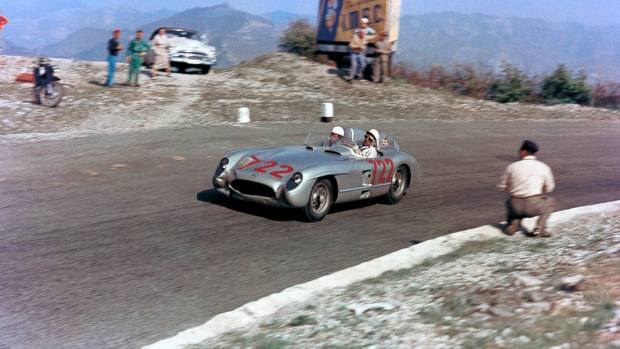
Racing drivers say that in order to finish first, first you must finish.
You see, the winner of a race is often not the fastest car. It’s the one that combines speed with reliability and consistency.
On Wall Street, we say that there are old traders and bold traders, but there are no old, bold traders.
The link between racing drivers and investors is their struggle to manage risk. Successful risk management is what separates winners from losers and investors from gamblers.
Financial risk management was born in the 1950s as curious academics like Harry Markowitz experimented with portfolio data to understand the volatility reducing benefits of diversification.
At the same time, racing drivers looked to science. Ferrari team driver Piero Taruffi used physics to estimate maximum cornering speeds on track.
At the apex of this period was the greatest drive of all time: Sir Stirling Moss’ record-setting win in the 1955 Mille Miglia.

The Mille Miglia was the toughest of all endurance races and attracted the world’s best drivers. Winners understood the risks and developed methods to manage them.
In 1955, Moss completed the twisty 922 mile race across Italy in a record 10 hours and 7 minutes. He beat his Mercedes teammate’s second place finish by an astounding 32 minutes.
We can only imagine how other competitors felt when Moss received an additional prize awarded to the most efficient driver.
Moss won by managing risk.
Specifically, Moss managed risk by developing a plan, employing a winning mindset to remove emotional reactions, controlling his car’s balance, and by analyzing data objectively.
Here's how he did it.
- Plan: Moss and his navigator “Jenks” wrote detailed course notes gleaned from 20,000 miles of testing that they mounted on scrolls for easy reading during the race. This was key to avoiding hazards while maintaining a high speed.
- Mindset: Following a mistake, Moss likely used what racing coach Ross Bentley calls a preplanned thought: a word or image to help refocus. After sliding off the road, Moss might have taken a deep breath and pictured the red Ferrari that was catching him.
- Balance: Moss used his brakes and throttle to manage the car’s weight balance between its front and rear wheels. This improved traction and allowed him to beat more powerful cars.
- Analysis: During each of their 20 reconnaissance laps, Moss and Jenks gathered information on fuel, brakes, and tire usage. They also noted dangerous sections of the course and created strategies to navigate them on race-day. This information led to reduced time in the pits and offered performance benchmarks.
Winning the race to build wealth
Let’s channel Moss’ incredible drive to build our own investment strategy.
Plan
If you fail to plan, you’re planning to fail. As investors, a plan starts with a goal. Perhaps to retire at 65 with a $3 million portfolio. Be specific. And realistic.
Then, like Stirling and Jenks, you’ve got to put in the time and effort to develop your plan. While a full plan is beyond the scope of this article, the basics for a retirement plan should include:
- A strategy to fund your portfolio.
- An understanding of your risk tolerance.
Buying investments that meet your goals. Selling those that no longer do.
Monitoring your portfolio monthly to confirm that you are on track.
Investing is an endurance race. Plan for the long road ahead.
Mindset
Like Moss, develop a positive mindset and learn to manage your emotions. An investment plan that is specific and realistic removes distractions so you remain calm when faced with a crisis.
A preplanned thought helps, too. For me, selling losing stocks is like decluttering my garage. When I clean out my garage, I feel unburdened. Selling a losing stock gives me the same feeling. Plus, I get to reallocate the money towards an investment that I’m optimistic about.
Limit emotional reactions.
Balance
Racing drivers manage a car’s weight balance using brakes and gas. In investing, we consider the balance between risk and return.
Our job is to develop a portfolio that earns a high return with low risk. How? By holding a portfolio that is diversified appropriately across asset classes. If you’re highly engaged with your investments, you might consider actively weighting your portfolio based on your own market forecasts.
Either way, the key to building wealth is to start early, invest a percentage of each paycheck, and then let returns compound over the long run.
Balance risk and reward in your portfolio.
Analysis
Top investors make objective decisions based on their understanding of data. To be efficient, they analyze data within a framework.
An investing framework should be as simple as possible, like measuring an investment’s quality and price. For an investment in stocks, the framework can be defined by two simple questions:
- Is this company any good?
- Is the current price reasonable?
A good company normally has solid earnings growth and future potential. It should have reasonable levels of financial risk and trustworthy management. To answer this question, check financial ratios, forward looking statements by management, and, of course, read TheStreet.com and Real Money!
Get exclusive access to portfolio managers and their proven investing strategies with Real Money Pro. Get started now.
To determine whether the stock price is reasonable, check valuation ratios like the P/E ratio. Next, look at the stock’s price chart to see if other investors see opportunity. Finally, if you’re interested in dividend income, check the dividend yield and analyze its sustainability.
Lastly, it’s not a good investment if it doesn’t fit with your investment plan.
Objective data analysis can keep you on pace.

Summary
The best athletes are risk managers. Stirling Moss won the 1955 Mille Miglia because he limited the threats to his success so that he could drive more conservatively than his competition.
Just like Moss in the Mille Miglia, we investors will make mistakes. But the lessons learned from car racing will help us stay on track.
Have a plan. Develop a positive mindset to manage your emotions. Balance risk and reward. And employ an objective, data-driven framework to manage your portfolio.
Good luck!







